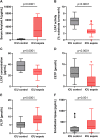Impact of Sepsis on High-Density Lipoprotein Metabolism
- PMID: 35071235
- PMCID: PMC8766710
- DOI: 10.3389/fcell.2021.795460
Impact of Sepsis on High-Density Lipoprotein Metabolism
Abstract
Background: High-density lipoproteins (HDL) are thought to play a protective role in sepsis through several mechanisms, such as promotion of steroid synthesis, clearing bacterial toxins, protection of the endothelial barrier, and antioxidant/inflammatory activities. However, HDL levels decline rapidly during sepsis, but the contributing mechanisms are poorly understood. Methods/Aim: In the present study, we investigated enzymes involved in lipoprotein metabolism in sepsis and non-sepsis patients admitted to the intensive care unit (ICU). Results: In 53 ICU sepsis and 25 ICU non-sepsis patients, we observed significant differences in several enzymes involved in lipoprotein metabolism. Lecithin-cholesterol acyl transferase (LCAT) activity, LCAT concentration, and cholesteryl transfer protein (CETP) activity were significantly lower, whereas phospholipid transfer activity protein (PLTP) and endothelial lipase (EL) were significantly higher in sepsis patients compared to non-sepsis patients. In addition, serum amyloid A (SAA) levels were increased 10-fold in sepsis patients compared with non-sepsis patients. Furthermore, we found that LCAT activity was significantly associated with ICU and 28-day mortality whereas SAA levels, representing a strong inflammatory marker, did not associate with mortality outcomes. Conclusion: We provide novel data on the rapid and robust changes in HDL metabolism during sepsis. Our results clearly highlight the critical role of specific metabolic pathways and enzymes in sepsis pathophysiology that may lead to novel therapeutics.
Keywords: CETP; LCAT (lecithin-cholesterol acyltransferase) activity; PLTP; endothelial lipase (EL); lipoprotein; sepsis.
Copyright © 2022 Reisinger, Schuller, Sourij, Stadler, Hackl, Eller and Marsche.
Conflict of interest statement
The authors declare that the research was conducted in the absence of any commercial or financial relationships that could be construed as a potential conflict of interest.
Figures

References
-
- Álvaro-Meca A., Jimenez-Sousa M. A., Jiménez-Sousa M. A., Micheloud D., Sánchez-Lopez A., Heredia-Rodríguez M., et al. (2018). Epidemiological Trends of Sepsis in the Twenty-First century (2000-2013): an Analysis of Incidence, Mortality, and Associated Costs in Spain. Popul. Health Metrics 16 (1), 4. 10.1186/s12963-018-0160-x - DOI - PMC - PubMed
Grants and funding
LinkOut - more resources
Full Text Sources
Miscellaneous

